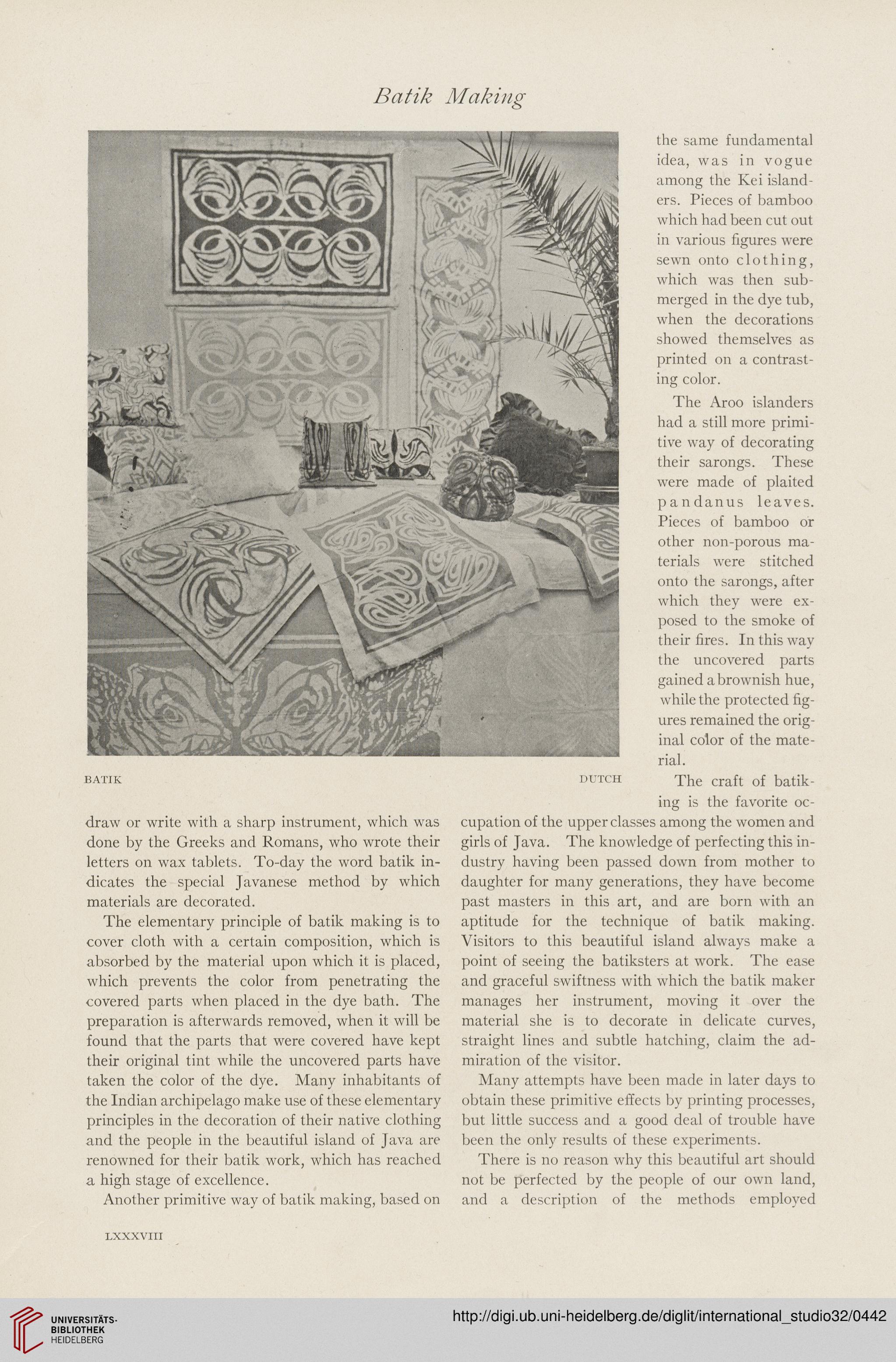Batik Making
BATIK
draw or write with a sharp instrument, which was
done by the Greeks and Romans, who wrote their
letters on wax tablets. To-day the word batik in-
dicates the special Javanese method by which
materials are decorated.
The elementary principle of batik making is to
cover cloth with a certain composition, which is
absorbed by the material upon which it is placed,
which prevents the color from penetrating the
covered parts when placed in the dye bath. The
preparation is afterwards removed, when it will be
found that the parts that were covered have kept
their original tint while the uncovered parts have
taken the color of the dye. Many inhabitants of
the Indian archipelago make use of these elementary
principles in the decoration of their native clothing
and the people in the beautiful island of Java are
renowned for their batik work, which has reached
a high stage of excellence.
Another primitive way of batik making, based on
the same fundamental
idea, was in vogue
among the Kei island-
ers. Pieces of bamboo
which had been cut out
in various figures were
sewn onto clothing,
which was then sub-
merged in the dye tub,
when the decorations
showed themselves as
printed on a contrast-
ing color.
The Aroo islanders
had a still more primi-
tive way of decorating
their sarongs. These
were made of plaited
pandanus leaves.
Pieces of bamboo or
other non-porous ma-
terials were stitched
onto the sarongs, after
which they were ex-
posed to the smoke of
their fires. In this way
the uncovered parts
gained a brownish hue,
while the protected fig-
ures remained the orig-
inal color of the mate-
rial.
dutch The craft of back-
ing is the favorite oc-
cupation of the upper classes among the women and
girls of Java. The knowledge of perfecting this in-
dustry having been passed down from mother to
daughter for many generations, they have become
past masters in this art, and are born with an
aptitude for the technique of batik making.
Visitors to this beautiful island always make a
point of seeing the batiksters at work. The ease
and graceful swiftness with which the batik maker
manages her instrument, moving it over the
material she is to decorate in delicate curves,
straight lines and subtle hatching, claim the ad-
miration of the visitor.
Many attempts have been made in later days to
obtain these primitive effects by printing processes,
but little success and a good deal of trouble have
been the only results of these experiments.
There is no reason why this beautiful art should
not be perfected by the people of our own land,
and a description of the methods employed
LXXXVIII
BATIK
draw or write with a sharp instrument, which was
done by the Greeks and Romans, who wrote their
letters on wax tablets. To-day the word batik in-
dicates the special Javanese method by which
materials are decorated.
The elementary principle of batik making is to
cover cloth with a certain composition, which is
absorbed by the material upon which it is placed,
which prevents the color from penetrating the
covered parts when placed in the dye bath. The
preparation is afterwards removed, when it will be
found that the parts that were covered have kept
their original tint while the uncovered parts have
taken the color of the dye. Many inhabitants of
the Indian archipelago make use of these elementary
principles in the decoration of their native clothing
and the people in the beautiful island of Java are
renowned for their batik work, which has reached
a high stage of excellence.
Another primitive way of batik making, based on
the same fundamental
idea, was in vogue
among the Kei island-
ers. Pieces of bamboo
which had been cut out
in various figures were
sewn onto clothing,
which was then sub-
merged in the dye tub,
when the decorations
showed themselves as
printed on a contrast-
ing color.
The Aroo islanders
had a still more primi-
tive way of decorating
their sarongs. These
were made of plaited
pandanus leaves.
Pieces of bamboo or
other non-porous ma-
terials were stitched
onto the sarongs, after
which they were ex-
posed to the smoke of
their fires. In this way
the uncovered parts
gained a brownish hue,
while the protected fig-
ures remained the orig-
inal color of the mate-
rial.
dutch The craft of back-
ing is the favorite oc-
cupation of the upper classes among the women and
girls of Java. The knowledge of perfecting this in-
dustry having been passed down from mother to
daughter for many generations, they have become
past masters in this art, and are born with an
aptitude for the technique of batik making.
Visitors to this beautiful island always make a
point of seeing the batiksters at work. The ease
and graceful swiftness with which the batik maker
manages her instrument, moving it over the
material she is to decorate in delicate curves,
straight lines and subtle hatching, claim the ad-
miration of the visitor.
Many attempts have been made in later days to
obtain these primitive effects by printing processes,
but little success and a good deal of trouble have
been the only results of these experiments.
There is no reason why this beautiful art should
not be perfected by the people of our own land,
and a description of the methods employed
LXXXVIII




